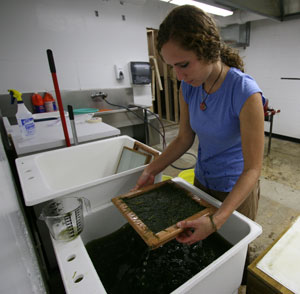Unique class assignment
Make a signature paper for CSB using natural plants and grasses from the area.
October 5, 2010
By Mike Killeen
College students receive homework assignments all the time. But in 2009, Ellory Eggermont received an assignment that couldn't be completed by opening a book or logging onto a computer.
The task? Make a signature paper for the College of Saint Benedict - and oh, by the way, make it with natural plants and grasses unique to the area.
 "It was something totally new to me," said Ellory, a CSB senior from Fargo, N.D. "I hadn't done any actual papermaking before. But I was interested in sustainable practices and the environment in general and the environment around us, specifically on the prairie. I wanted to get some experience definitely learning a new process to its fullest extent."
"It was something totally new to me," said Ellory, a CSB senior from Fargo, N.D. "I hadn't done any actual papermaking before. But I was interested in sustainable practices and the environment in general and the environment around us, specifically on the prairie. I wanted to get some experience definitely learning a new process to its fullest extent."
Some 500 sheets of handmade paper later, Ellory aced her assignment.
"I'll use the paper for my senior art project, which all senior art majors have to do in the fall and the spring," Ellory said.
A nationally known papermaking artist, Mary Hark - who is a CSB alumna - initially suggested the idea to make a signature paper from natural materials at the College of Saint Benedict and Saint John's University. The Literary Arts Institute brought together members of the English, art and biology departments at CSB and SJU to investigate how the paper might be made.
Only one hurdle remained - find someone to make the paper.
Enter Ellory. Rachel Melis, assistant professor of art at CSB and SJU, said Ellory was selected because of "a combination of her art experience and her environmental-ecological interest."
So off Ellory went to the prairie and forest areas around CSB and SJU in the summer of 2009. She looked for grasses that she could use in the papermaking process. A trial and error period followed - pick grass, make paper, see how it turns out.
"It (the project) sort of became her life," Rachel said. "I can't think of anyone doing a better job with that than her. She ran with it."
Stephen Saupe, professor of biology at CSB and SJU, suggested certain plant species and research methods in Ellory's papermaking process, including using a blue dye - often used in biology experiments - to track the transformation of the materials microscopically as they were beat into paper. Eventually, she settled on a combination of Big Bluestem and Reed Canary grasses.
"That makes a fairly nice artistic paper, but in order to write on it, I added sizing, which is a chemical that helps the paper hold ink. And, I added flax, because it's something that's grown historically right here at Saint Ben's. That makes the paper a lot nicer, softer and lighter in color," Ellory said.
The proximity to these natural elements at CSB and SJU played a big role in the project.
"Here we have a very direct connection to the land we live on, and that was the main influence for this project, to create something that's specifically from Saint Ben's and Saint John's," Ellory said. "And, the grass is quickly renewed. The grass I took from the prairie last year has already been replaced. Trees are renewable, but it might take 100 years (to grow)."
Ellory, who wants to be a college art teacher, said she has grown as a person because of the project.
"I think personally for me, I've learned how valuable it can be to put yourself out there and get involved in something that you have no idea about," Ellory said. "I also gained a greater appreciation of my direct environment of the arboretum that surrounds me, as well as the prairie and woods at Saint Ben's, and starting to figure out how the place I live influences who I am."
Both Scott Murphy, assistant professor of art at CSB and SJU, and Ellory will present a workshop on papermaking during the Friends of Dard Hunter National Papermaking Conference Oct. 18-24 in Gatlinburg, Tenn. Scott said they will address the collaboration between various departments (including environmental studies and Undergraduate Research) to produce the paper "and the benefits to both students and faculty."
"Ellory has come up with a paper that is of this place," Scott said. "It combines elements of fibers that have historical connections and local connections or a changing environmental connection."
